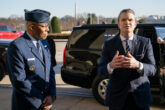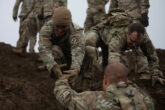May 27, 2014
Bensahel: A Slower Zero Option
President Obama’s decision to keep U.S. troops on the ground in Afghanistan through the end of 2016 is good news for U.S. military commanders and others who argued against the “zero option.” U.S. troops will now be able to continue training and counter terrorism missions in Afghanistan for two more years, rather than having to withdraw by this December.
Yet make no mistake: this decision may be slower and gentler than the “zero option,” but it is still a path to zero. The 9,800 U.S. troops that remain in Afghanistan at the beginning of 2015 will continue to conduct those two important missions in Kabul and key regional cities. But that force will be cut in half by the end of 2015, which will limit those missions to Kabul and Bagram. And by the end of 2016, the only remaining U.S. troops will be those working in the Office of Security Cooperation in the U.S. Embassy.
The challenge facing U.S. commanders in Afghanistan, then, is to use this limited time to ensure that the Afghan National Army (ANA) can operate as effectively as possible without U.S. assistance. While ANA troops and small units have improved a lot in recent years, they still lack the enabling forces, logistics, and staff capabilities needed to fully function on their own. Perhaps counterintuitively, U.S. forces can best help them achieve this goal by removing themselves almost completely from ANA operations, even on the support side, and helping the Afghans figure out the best workarounds and solutions to the problems that inevitably emerge.
The ANA needs to demonstrate that it can truly act independently for reasons that extend far beyond the battlefield. To be blunt, the Afghan government cannot afford to maintain the ANA. The United States and its international partners have been footing the bill, and they are likely to continue doing so as long as there are U.S. troops on the ground. But those funds may well dry up when those troops depart at the end of 2016. Congress will be reluctant to continue signing billion-dollar checks at that point under any circumstances, but will certainly not do so if the ANA has not proven that it can operate independently by then.
Drawing down to zero by December 2016 will certainly protect U.S. interests better than drawing down to zero by December 2014. But the clock is still ticking loudly, with a tremendous amount that needs to be accomplished in an ever-shrinking period of time.
More from CNAS
-
Hegseth Brings the Culture War to Combat
The fundamental challenge of military leadership lies in creating cohesive teams that can work together in an environment of mortal risk and, when called upon to do so, use le...
By Dr. Jason Dempsey
-
Hegseth Says Trump Boosted Military Recruiting. It’s Been Improving for over a Year
Defense Secretary Pete Hegseth says military recruiting has shot up since the Trump administration's return. In fact, it's been improving for at least a year, with big jumps i...
By Taren Sylvester
-
Pete Hegseth’s Views About Women and Military Standards
In recent weeks, Hegseth walked back comments made while promoting his book, where he said women did not belong in ground combat units. Without citing specific examples, he co...
By Katherine L. Kuzminski
-
Sharper: Trump's First 100 Days
Donald Trump takes office in a complex and volatile global environment. Rising tensions with China, the continued war in Ukraine, and instability in the Middle East all pose s...
By Charles Horn




